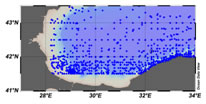Operational Forecasting Methodology
The operational forecasting of the TSS circulation and exchange follows model development by Gürses et al. (2016) and Aydoğdu et al. (2017). Further development of the model and updates have been accomplished as part of the Copernicus BS-MFC program system evolution.
The BS-MFC aims development of inter-basin coupling as part of the Black Sea forecasting. Within the modeling framework, the FESOM model is used for the TSS, based on a high-resolution grid of the bathymetry and geometry, following Aydoğdu et al. (2017). The model is now developed further allowing more realistic net water fluxes through the TSS and allowing seasonal climatological conditions in adjacent basins to set the environmental constraints.
The present 5-day operational forecasts are produced under atmospheric surface conditions supplied by the European Center for Medium-Range Weather Forecasts (ECMWF), by the auspices of the Turkish State Meteorological Office.
In comparison to the latest model version of Aydoğdu et al. (2017), major changes have been made in terms of fluxes and seasonal climatology of the adjacent basins. Firstly, the fresh water flux supplied at the Black Sea buffer zone, originally balanced with surface fluxes elsewhere in the modeling domain in Aydoğdu et al. (2017), is now required to be balanced by those fluxes and the amount equivalent to the Black Sea water input extracted from the Aegean Sea buffer zone. Secondly, seasonal climatologies of salinity and temperature varying with depth and with time (z-t) are applied uniformly in the horizontal in the adjacent Black Sea and Aegean Sea three-dimensional domains, forcing seasonal variations in exchange, while initialization in the entire domain is also based on seasonal climatology constructed from historical observations (Özsoy and Altıok, 2016a,b).
The data base available at the IMS-METU and based on our past measurements have been used in the construction of the seasonal climatological time-series as a function of depth and time at daily resolution, in the three separate regions of interest: the northern Aegean Sea, the Marmara Sea and southwestern Black Sea domains of the forecast model. The seawater properties in the Black Sea and Aegean Sea domains are relaxed to the seasonal climatology with a relaxation time of 15 days.



Figure 6.1 The northern Aegean Sea, the Marmara Sea and southwestern Black Sea domains and locations of stations where the data have been averaged to construct a depth and daily time-series of climatological temperature and salinity used in forecast model relaxation to climate in adjacent basins of the Black and Aegean Seas and as initial conditions in the Marmara Sea.



Figure 6.2 Seasonal evolution of temperature in the Aegean, Marmara and Black Sea sub-regions of the BS-MFC FESOM model domain.



Figure 6.3 Seasonal evolution of salinity in the Aegean, Marmara and Black Sea sub-regions of the BS-MFC FESOM model domain.